|
Dorothy Wyndlow Pattison was born on
16th January, 1832 at the village of Hauxwell, North
Yorkshire, where her father Mark Pattison was rector of the
village church. She was the eleventh child of Jane and Mark
Pattison and lived in Hauxwell Rectory. There were ten girls
and one boy. Another boy was born later.
Sadly she had a terrible childhood,
blighted by the mental state of her depressive father, and
seemingly unloved by her mother. Shortly after her birth,
her brother Mark left home to become a student at Oxford
University. Her father greatly resented his lack of
promotion in the church, and couldn’t cope with the gap left
by his son’s departure for Oxford. In 1835 he had a mental
breakdown and was sent to an asylum in York where he was
badly treated. On his return home his illness worsened, and
his resentment turned towards his family, for sending him to
the asylum. He was sometimes violent, but Jane, his
submissive wife would always do his bidding, which included
forbidding his daughters to marry.
The girls were not allowed any formal
education beyond learning to read and write. They were left
to find their own amusements, and for a time (until
forbidden by their father) they ran the village school, and
became involved in charitable activities such as
distributing food and visiting the sick. Their elder brother
Mark, a brilliant student, became involved in the Oxford
Movement, a group of High Church Anglicans who wanted to
reinstate lost Christian traditions and include them in
Anglican liturgy and theology. They conceived the idea of
the Anglican Church being one of three branches of the
Catholic Church. Mark became Rector of Lincoln College,
Oxford.
Under Mark’s influence, his sisters
embraced the Oxford Movement, in face of their father’s
fierce opposition. Dorothy became his favourite sister, and
on several occasions accompanied him on holiday, which
allowed her to escape from the terrible conditions at home.
Unfortunately the close relationship did not survive. When
she became a nurse a few years later, he was angered because
he thought this to be an unsuitable occupation for one of
his sisters. They drifted apart, and when she died he
refused to attend her funeral.
|
|
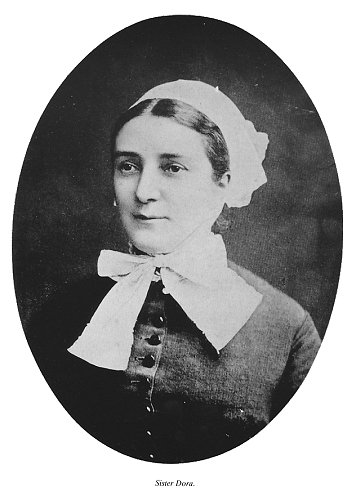
From an old postcard. |
Whilst in her twenties Dorothy had a
couple of affairs. The first was with James Tate, the son of
the headmaster of Richmond School. The Tates were close
family friends, and James soon fell in love with the
attractive twenty year old. They intended to marry, but
James easily gave-in to her father’s refusal, which greatly
angered her.
At the same time she had a secret affair with
Purchas Stirke, a young farmer’s son who she met while fox
hunting with her sister Rachel. Purchas’s brother Robert
fell in love with Rachel, and they were married. She was
banished from her family home forever by her father.
Dorothy’s mother became fatally ill,
and Dorothy became her full-time nurse. After her mother’s
death in 1860 Dorothy decided to break-off her engagement to
James, because, as she secretly admitted to Rachel, she
preferred Purchas Stirke. This however was not to be. She
decided to end the affair with Purchas, and with the ninety pounds
left to her in her mother’s will, she decided to leave home
and start a new life elsewhere. |
|
She obtained the post of schoolmistress
in the village of Little Woolston, Buckinghamshire where she
taught the sons of the local farm workers to read. In
November 1862 she took a holiday at Coatham near
Middlesbrough to recuperate from an illness. While there she
bumped into James, who again proposed, and she accepted. But
the marriage was not to be because of a hostile reaction
from his family.
During the following year she returned
to Coatham to look after her sister Frances who was
recovering from a nervous breakdown. While there she saw the
work of the Sisters of the Good Samaritan Order and was
greatly impressed. The sisters’ lives were devoted to strict
religious observance, and charitable work, the things she
aspired to, mainly because of her brothers’ influence and
his work with the Oxford Movement.
Her sister Frances joined the order,
and one year later, in September 1864 so did Dorothy. She
took the name Sister Dora. The sisters’ duties included
nursing patients in the Cottage Hospital at Coatham, and the
Cottage Hospital at Walsall. One of Sister Dora’s heroes was
Florence Nightingale and so the idea of nursing the sick
must have greatly appealed to her.
Sister Dora’s nursing career began at
Coatham. Nursing was under the supervision of Sister Mary
Jacques who greatly influenced her, especially because she
had trained at Kaiserwerth Hospital in Germany, where
Florence Nightingale had worked. Sister Mary had been
working in the hospital at Walsall until she caught scarlet
fever and had to return to Coatham to convalesce. Sister
Dora was hurriedly sent as a temporary replacement, and
arrived at Walsall for the first time on 8th January, 1865.
After staying for two months she returned to Coatham, and in
November came back to Walsall, where she stayed for the rest
of her life.
|
|
Sister Dora and Sister Mary were
initially treated with suspicion, and even hostility by many
local people. At the time anti-Irish and anti-Catholic
feeling was rife in the town. Sister Dora soon caught
smallpox from an outpatient and was confined to her room, in
which the blinds were drawn. This led to a rumour that the
room was an oratory containing a figure of the Virgin Mary
wearing a crown. Stones and mud were thrown at the hospital
widows, but the dedicated sisters carried on caring for the
sick as usual. The hostility gradually faded as people came
to appreciate the sisters’ devotion to duty and their
difficult undertaking. They also worked in the community
visiting outpatients, some of whom were severely injured.
In 1866 she fell in love with a young
surgeon, possibly John Redfern Davies. They were soon
engaged, but this led to a dilemma, stress, and illness. He
was an atheist, and she knew that she would have to choose
between him, and her Christian beliefs, and charitable work.
She decided that she could not give-up her work and so the
engagement ended. She knew that she had badly let him down,
which resulted in illness from stress.
In 1867 the Sisterhood was
reconstituted into a proper religious order, and Sister Dora
was given the opportunity to take vows. Instead she decided
to stay in Walsall serving the local community, where her
true vocation lay.
|
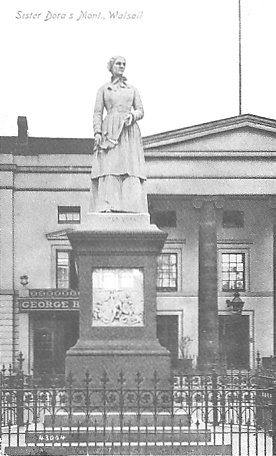
From an old postcard. |
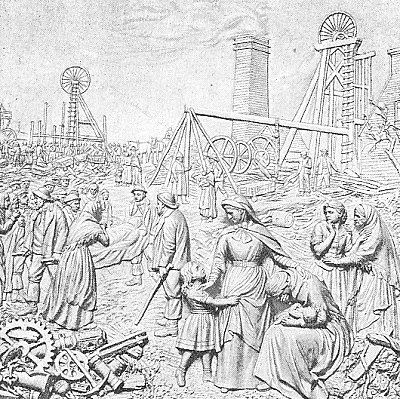
One of the reliefs on Sister Dora's
statue depicting the Pelsall mine disaster of 1872. |
In May 1868 when the new Cottage
Hospital opened she was in sole charge of all aspects of
nursing. She attended post mortems and dissections to learn
new skills, and set about making the hospital the best of
its kind in the country. She became an expert in the
treatment of lacerations, at setting fractures, and treating
eye injuries.
Other hospitals tried to tempt her away
by offering a higher salary, but she was not interested, her
devotion to duty came first.
The hospital’s new surgeon
James MacLachlan was greatly impressed with her and tried to
persuade her to train as a doctor, but Sister Dora’s
commitment to nursing, and desire to help others came first.
To give this up for several years whilst training as a
doctor was very much against her beliefs.
|
|
She looked after her patients extremely
well, and paid attention to the minutest details of their
care. She insisted on high standards of comfort and care,
rigorous cleanliness everywhere, and nutrition, supervising
each meal herself.
She is particularly remembered for her
valiant work and devotion to care after two serious
industrial accidents, and a smallpox epidemic. The first
accident happened at Pelsall Colliery on 14th November, 1872
when the pit rapidly flooded, trapping twenty two men and
boys underground for five days. Sadly they all died before
help could reach them, but Sister Dora lived with the
waiting relatives, distributed blankets and food at the
pithead, and did everything possible to support and comfort
them at that terrible time.
|
|
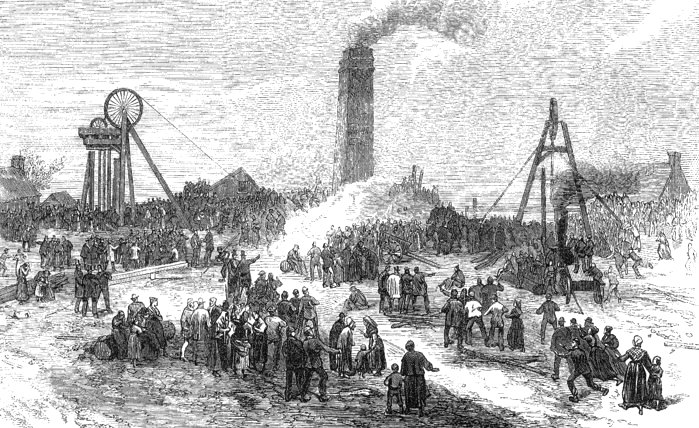
Pelsall Colliery. From The
Illustrated London News. |
| The employees of the London & North
Western Railway were so impressed with her efforts after the
accident that they subscribed fifty pounds out of their
wages (a substantial sum at the time) to present her with a
pony and trap. The presentation took place on 20th June,
1873. |
| In February 1875 a virulent smallpox
epidemic broke out in Walsall. Although the Epidemic
Hospital in Hospital Street, built in 1872, had all of the
necessary facilities, it gained a terrible reputation. Sufferers preferred to take their chances at home
rather than enter the hospital.
Sister Dora knew that the
only way to control the disease was to isolate the
sufferers, and so she moved into the Epidemic Hospital on
28th February and took charge. Her reputation was such that
people soon changed their mind and were convinced of the
benefits of entering the hospital.
She was assisted by two old women from the workhouse to
wash clothes and bedding and was visited daily by a doctor and the secretary from the
Cottage Hospital.
She stayed at the hospital for six months until August
1875 when the epidemic was over. |
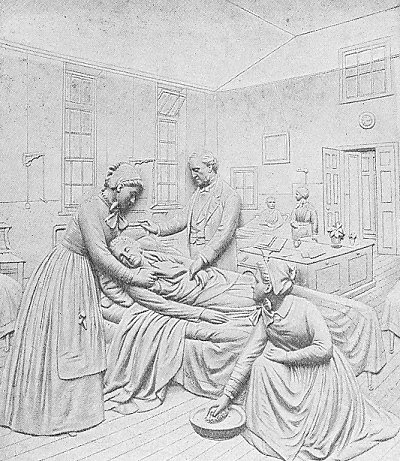
Another of the reliefs on Sister
Dora's statue showing her caring for the sick. |
| The following is from a
letter that was sent by Sister Dora. It is
from D. C. Woods' book, 'A Documentary
History of Walsall and District in the
Nineteenth Century.'
My room is between the wards, with little
windows as you have, peeping into both. My
bed in one corner, chest of drawers, and
slip for my basin. The doctor said it 'smelt
of pox' this morning; and no wonder - they
were airing all the sheets by my fire when I
came in. I think the most infectious thing I
have to do is to nurse the babies, taking
them streaming out of their mothers' arms.
One has the pox on its arms and chest very
slightly. Our worst case is a lad of
eighteen. He vomits everything, and is so
delirious; he got out of his bed this
morning, and I thought he had escaped into
the town, but I found him in an empty ward.
All the patients are
alive but that is generally the case with
smallpox and dirty people. I could only
venture to wash their hands and faces in hot
water this morning. I have had to make
garments for my urchins today; it is very
difficult to get anything here. Everything
has to be ordered at the Town Council
office. I see -- - is timid! He kept a
respectful distance today from me and the
patients, but do not tell him I said so . .
. I am going to send a letter to the
patients, which you are to read to them, and
you must tell me what they say. As I read
the prayers this morning I saw the tears
roll down one woman's face, who I know is
living in sin with a man I have nursed.
There is not one case in who does not know
me.
One of the police came
to see me to-day, and he said they declared
in the town they should not mind having the
smallpox with 'Sister' to nurse them. I
declare I taste it in my tea. I have made my
room look as respectable as I can . . . . Is
not this a glorious retreat for me in Lent?
I can have no idle chatter. |
|
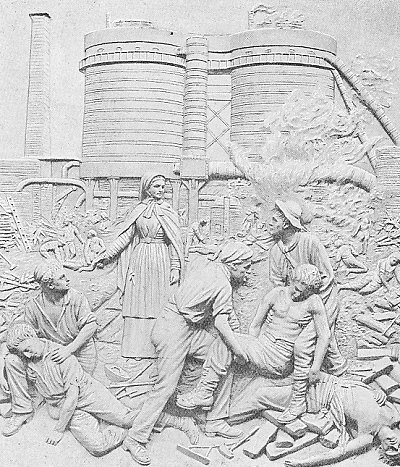
The relief on the statue which depicts
the Birchills furnace explosion. There is no evidence to
suggest that she actually went to the scene of the
explosion. |
The second industrial accident for
which she is remembered took place on 15th October, 1875 at
Birchills Iron Works.
A blast furnace exploded as it was
being tapped, when a tuyère
burst. The furnace workers were covered with molten metal and red hot ashes.
Three men died instantly, and twelve others, all with
serious burns were rushed to the Cottage Hospital.
Sister
Dora immediately took charge of the men and treated them
alone, shutting herself up in their side ward, nursing them
both day and night for several weeks. Despite all of her
efforts, ten of them died from their terrible injuries.
At the time burns would often be
infected and were difficult to treat. The men’s presence,
and their infected wounds had infected the whole hospital
with erysipelas, which meant that the wounds of new patients
would also be infected. Contemporary medicine offered no
solution, the only option was to close the hospital.
|
| |
|
| Read a contemporary account
of the Birchills explosion |
 |
| |
|
|
The Sisters of the Good Samaritan Order
wanted Sister Dora to move elsewhere, but she refused. When
asked why, she replied "I am a woman not a piece of
furniture!" Around this time she severed her formal
links with the Sisterhood, but retained the name Sister
Dora.
While a new hospital was built, a
temporary hospital opened in a house in Bridgeman Place,
owned by the London & North Western Railway. It
was far from ideal, only having ten beds on four floors.
There was little space, and not even enough room to
manoeuvre a stretcher between floors. Patients (alive or
dead) had to be carried, usually by Sister Dora herself.
Because of the lack of space many people had to be treated
as outpatients. In 1877 over 15,000 people were treated in
this way, usually by Sister Dora. The hospital was close to
the railway and so patients were continually disturbed by
passing trains.
The house was far from suitable for use
as a hospital. In 1878 it became infected with typhoid fever
and had to be closed.
Sister Dora refused the honour of
laying the foundation stone for the new hospital, but was
deeply involved in planning the new building, continually
suggesting amendments to the plans.
During 1877 she began to suffer from
exhaustion. This gradually worsened and so she consulted two
doctors who both confirmed that she was suffering from
breast cancer. Although a mastectomy was a possibility, the
procedure had not been fully mastered, and often left the
patient an invalid. Because of this it was seldom carried
out.
|
|
She decided to carry on with her work,
in the certainty that she only had a short time to live. She
kept the disease secret and decided to treat it herself.
After the hospital closed, Sister Dora visited London and
Paris. While in London she attended operations conducted by
the surgeon Joseph Lister, a pioneer of antiseptic surgery.
She quickly realised its benefits and ensured that the new
hospital would have the necessary equipment.
In September her health deteriorated. She returned to
Walsall to inspect the building work, but felt too ill to
look for lodgings. She returned to a hotel in Birmingham
where she collapsed. She was given two weeks to live, and
greatly wanted to return to Walsall so that she could die
amongst her own people.
The hospital committee
rented a small house for her in Wednesbury Road, where she
arrived on 8th October. She was in constant pain, and found
it difficult to breath, and couldn’t take solid food.
|
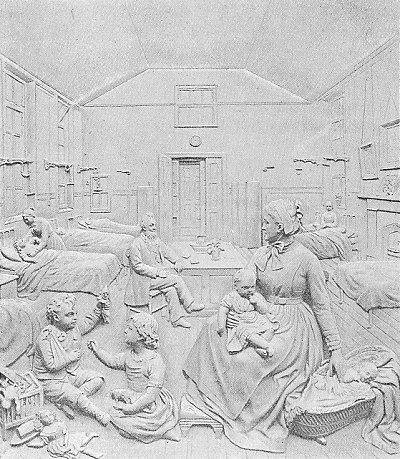
The final relief showing her caring
for children. |
|
It had been hoped that she could
perform the opening ceremony when the new hospital opened on
4th November. Unfortunately she was too ill to be there. She suffered for three months. The end
finally came on December 24th. She asked friends and
colleagues to leave her bedside saying “I have lived alone,
let me die alone.” The end finally came at 2 p.m.
Her funeral took place on Saturday 28th December. She had
wanted a quiet affair, but it was not to be. The coffin was carried to Queen Street Cemetery by
eighteen railway workers, and watched by large crowds who
came to pay their last respects.
The crowd delayed the long procession from
the Cottage Hospital. It included members of the police
force, choristers and senior choir members, physicians and
surgeons, clergy and ministers, mourners, the executor
James Slater, the executive committee, the Mayor and
Councillors, representatives of the press, the Governors of
Queen Mary’s School, the Guardians of the School Board, old
patients, and many others. The funeral was an elaborate
affair. Sister Dora had chosen the words for her headstone
herself. It simply reads:
In memory
of Sister Dora who entered into rest on Christmas Eve 1878
She is remembered by a stained glass
window in St. Matthew’s Church, and the statue on The
Bridge. It was paid for by public subscription. The
collection began in 1879, and the statue was unveiled on
Monday 11th October, 1886. The unveiling ceremony was a
civic affair, with a long procession starting at the
hospital. Most of the town came to watch.
|
|
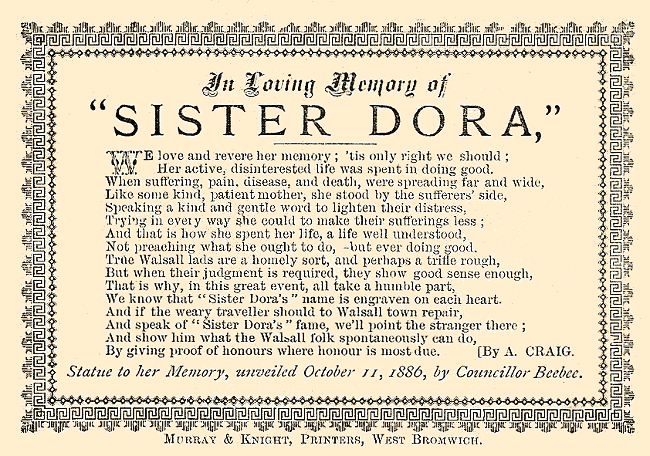
A memorial card for Sister Dora. Courtesy of Christine and John Ashmore. |
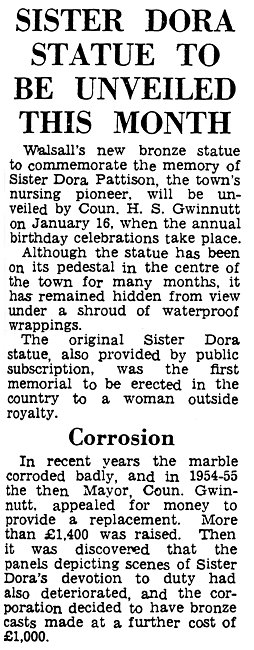 |
Sister Dora's marble statue on
The Bridge, was replaced with a bronze replica in 1957, as
can be seen from the newspaper article on the left,
dated 2nd January, 1957. |
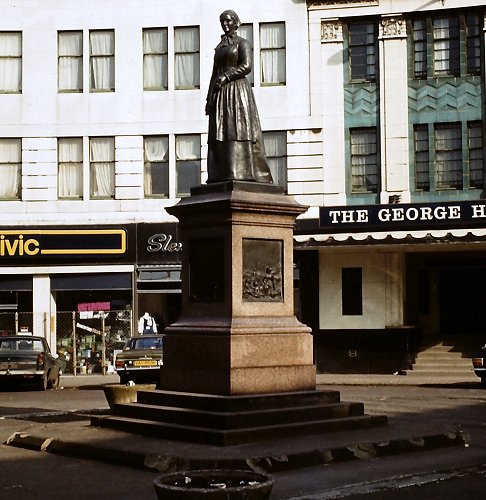
Sister Dora's statue in the mid 1970s.
Taken by Richard Ashmore. Courtesy of John & Christine Ashmore. |
| Even though she
died over 130 years ago, she is still remembered by most
people for her outstanding work and devotion to duty. |
 |
Return to
the
previous page |
|